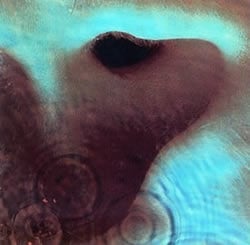1971 – Pink Floyd – Meddle
Links – Rate Album and Discuss |
|
Check Current Prices Below! |
  |
|
Track Listing: 01. One Of These Days |
| Rate Album and Discuss |
Meddle is an album by English progressive rock band Pink Floyd. It was recorded at various studios in between the band’s live touring commitments from January to August 1971.
Originally released in the U.S. on 30 October 1971 by Harvest/Capitol and in the UK on 5 November by Harvest/EMI, the album was later remastered three times: first by MFSL in 1984 on high-quality vinyl and cassette, then in 1989 for Ultradisc, and finally by Doug Sax (supervised by James Guthrie) for the 1992 Shine On box set. This latter digital master was used for a CD reissue with additional artwork by Hipgnosis, released August 1994 in Europe and April 1995 in the U.S.
Miscellaneous Information
General Overview
Though the tracks have a variety of moods, Meddle is generally considered more cohesive than its 1970 predecessor Atom Heart Mother, and is thought by many fans to be Pink Floyd’s first truly great album recorded without Syd Barrett. It enjoyed some commercial success in the United Kingdom (reaching #3 on the charts), but lacklustre publicity on the part of Capitol Records led to weak sales in the U.S. However, Meddle was later certified Gold by the RIAA in October 1973 and then double platinum on 11 March 1994 following the added attention garnered by the band’s later successes in America.
“One of These Days” opens the album with an ostinato bassline, played by both Gilmour and Waters, with Gilmour playing slide guitar. In later years, Gilmour would play the slide part with a lap steel guitar, mounted on legs, similar to a pedal steel guitar. A largely instrumental piece, the only lyric, ‘One of these days I’m going to cut you into little pieces’, is spoken by Nick Mason. It is followed by “A Pillow of Winds”, which is distinguished by being one of the few quiet, acoustic love songs in the Pink Floyd catalogue. These two songs segue into each other via wind effects, anticipating the same technique that would later be used on Wish You Were Here.
The song “Fearless” employs field recordings of the Liverpool F.C. Kop choir singing “You’ll Never Walk Alone”, their anthem, which brings the song to an end in a heavily reverberated fade-out. “San Tropez”, by extreme contrast, is a jazz-inflected pop song with a shuffle tempo, composed by Waters in his increasingly-deployed style of breezy, off-the-cuff songwriting. Pink Floyd give a rare glimpse into their sense of humour with “Seamus”, a pseudo-blues number featuring a dog howling along to the music. “Seamus” was remade as “Mademoiselle Nobs”, featuring a different dog and no lyrics, in the film Pink Floyd: Live at Pompeii.
The final song on the album is the 23-minute underwater epic “Echoes”. “Echoes” also gave its name to the compilation album Echoes: The Best of Pink Floyd, on which a much-edited version of the title track was included. In the compilation, multiple edits throughout the entire song cut the running length of the piece down by some 7 minutes.
Recording and Release
Pink Floyd began production on the album at EMI’s famous Abbey Road Studios, where most of their other projects had been recorded and mixed. Lacking a central theme for the project, the band decided to work on new material individually without listening to the other band members’ contributions. They had already tried such an approach with limited success for Ummagumma. However, this time the band resolved to work on one collaborative piece rather than separate solo efforts. The result of one such experiment, which centered around the sound of a grand piano sent through a Leslie speaker, provided inspiration for what would later become “Echoes”.
Unfortunately, Abbey Road was still only outfitted with 8-track multitrack recording facilities, which Pink Floyd found insufficient for the increasing technical demands of their project. They transferred their best efforts, including the opening of “Echoes”, to 16-track tape at smaller studios in London (namely AIR and Morgan) and resumed work with the advantage of more flexible recording equipment. Engineers John Leckie and Peter Bown recorded the main Abbey Road and AIR sessions, while for minor work at Morgan studios in West Hampstead Rob Black and Roger Quested handled the engineering duties. The band also spent several days in late September 1971 preparing a quadrophonic mix of the album at Command Studios. Reportedly, this was played at the album’s press premiere. However, it has never been released to the public.
Outtakes from the album sessions are rumoured to include an unreleased song entitled “The Dark Side of the Moon”, which later became “Brain Damage”, and two demo versions of “One of These Days”, both of which have been made available on bootlegs and include cut-up speech samples of Radio DJ Sir Jimmy Young.
Soundclips from the album were used in the 1990 film Rosencrantz and Guildenstern are Dead.
Album Art
The band’s associate Storm Thorgerson originally suggested a close-up shot of a baboon’s anus for the album cover photograph. The band informed him via an inter-continental telephone call while on tour in Japan that they would rather have “an ear underwater”, which was used as the basis for the final design (with major colour differences on the original U.S. and Canadian issues of the album).
This image formed the outside of the original gatefold cover, while four superimposed black-and-white photographs of the individual band members were used for the interior. This is the last time that the four band members appeared on an album sleeve. The opened inner gatefold is displayed in what appears to be a shrine in the video for the song ‘Push The Lil Daisies’ by Ween.

